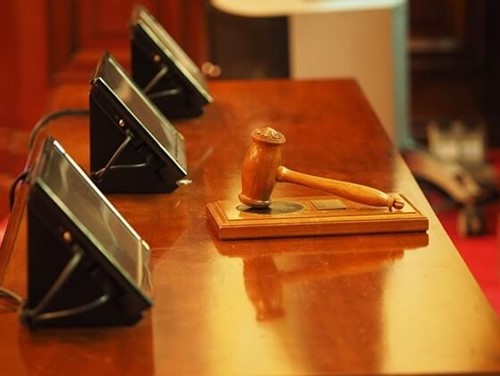Every employer will face work issues from time to time. Sometimes, these can only be resolved at an employment tribunal.
Anyone can decide to make a claim. So, it's important to know how to deal with them. If not, you could pay compensation and face business damages.
In this guide, we'll look at what an employment tribunal is, different types of claims, and how they're resolved.
What is an employment tribunal?
An employment tribunal is a public body who deals with work-related disputes.
A tribunal isn't as formal as a government court of law. But their final decisions are legally binding. Making a claim at a tribunal is quicker and cheaper, compared to courts.
Both parties may find it hard to understand employment law. So, they'll often bring a trade union or legal representative.
The person raising the dispute is the 'claimant' (usually the employee). And the one who receives it is the 'respondent' (usually the employer).

What claims does an employment tribunal deal with?
From unfair dismissal to disability discrimination; there are many disputes raised as a tribunal claim.
However, most claims revolve around:
- Dismissal: This can include wrongful, constructive, and unfair dismissal.
- Equal pay: This covers equal pay rights, reduced wages, or not being paid at all.
- Redundancy: This includes unfair selection or not being paid wages during redundancies.
- Discrimination: This covers all nine protected characteristics. (Age; disability; gender reassignment; marriage or civil partnership; pregnancy and maternity; race; religion or belief; sex; and sexual orientation).

What is the law on employment tribunals?
An employment tribunal is separate from to civil legal proceedings. But they'll need to follow the Employment Tribunals Rules of Procedure 2013.
Any worker or job applicant can make a claim - it's part of their employment rights. They're protected from discrimination and victimisation. So, you can't treat them unfairly for making a claim against you.
Both sides must follow the proper steps for the tribunal. If you don't provide the correct documents or miss the hearing date, the claimant may automatically win.
Do you have to pay to raise an employment tribunal claim?
You don't have to pay to raise a claim to an employment tribunal.
In 2017, tribunal fees were declared unlawful by the Supreme Court. Getting rid of the fees meant employees could make a claim without facing financial costs.
Employees can now use an online service, without having to pay any fees.
But if they want to raise an appeal claim (to the Employment Appeal Tribunal), they should do this via writing or email.

Using settlement agreements instead of employment tribunals
Sometimes, you can solve employment disputes outside of a tribunal.
This is where both parties decide on settlement agreements. These decisions must be fair and signed to in writing.
If the claimant wants to settle, they must withdraw the employment tribunal claim. Only then can they accept the settlement. (But this is usually done under a COT3 form via ACAS).
You can't use settlements for specific disputes, like unfair dismissal or discrimination. Here, you'll need to follow proper tribunal procedures.
Using early conciliation instead of employment tribunals
Another way to solve a dispute is through early conciliation.
A middle person (or 'conciliator') will help resolve matters between both sides. They'll offer different ways to reach an agreement. But they can't enforce any decisions - only suggest them.
Conciliation helps to keep positive work relations. But people see the meetings as too informal. Final decisions aren’t always legally binding (unless they go through a COT3 process).

How do you respond to employment tribunal claims
Employers can face a workplace dispute from nowhere. That’s why it’s important that you prepare for them.
You shouldn't discipline anyone for making a claim. If you do, you could be liable for victimisation.
It's best for the employee to contact ACAS first. From here, let's look at the next steps in more detail:
Check employee responsibilities are met
The claimant needs to complete certain steps before a tribunal claim is issued. If any steps are missing or incomplete, it could make a claim invalid.
Employees should:
- Check time limits for the claims.
- Follow the dispute resolution process of the business.
- Comply with ACAS Code of Practice on Disciplinary and Grievance Procedures (if relevant).
- Start early conciliation. (They'll need an early conciliation certificate to show the dispute hasn't been settled).
Reply to the Form ET1
If both parties have gone through an unsuccessful early conciliation process, the employee can make a claim.
They have to submit a Form ET1 and submit it to the employment tribunal. This is sent to both the respondent and ACAS.
There are strict time limits for the employer, as they'll need to reply within 28 days. You may seek legal advice on managing claims. But a late response could lead to an automatic 'win' for the claimant.
Your response should cover all the main points of your argument. If an employer withholds vital information, they could be penalised.
Go to the preliminary hearing
It's possible for the employer to be invited to a preliminary hearing. These hearings explore claims in more depth before the final hearing.
The tribunal will outline how to prepare for the final hearing. This is also known as 'giving directions'. For example, they could ask for copies of witness statements or work papers.
The tribunal will look at all evidence and accounts at the final hearing.

How do you prepare for an employment tribunal hearing?
The tribunal claim isn’t resolved the formal hearing, unless the claim has been rejected.
From here, all proper steps must be followed before a final decision is reached.
To prepare for the hearing, the employer must:
Present all relevant documents
The tribunal may ask the respondent to present all kinds of documents. They might ask for digital or hard copies.
A copy should be given to the claimant and representatives (i.e., like trade union officials). These documents can include contracts, emails, and meeting minutes.
They may also ask employers to present witness statements, too. These are personal accounts of people who agree to give evidence.
Attend the formal hearing
After the preparations, the employer needs to attend the formal hearing.
An employment tribunal judge will set out the key matters of the dispute. They'll ask relevant people to present their statements. For example, trade union representatives or witnesses.
In most cases, you'll be asked questions by the judge or the panel. Usually, the other party will ask questions, too.
Wait for a final decision
At the end of the hearing, both sides will present a final statement. Then, the tribunal judge will announce final steps.
They may decide to adjourn the hearing and reconvene at a future date. Maybe they need further evidence or need to consider new circumstances.
Other times, the judge will pass a final decision at the end of the hearing. Depending on the tribunal claims, the judge may award:
- Reinstatement: This is when employees get their job back.
- Re-engagement: This is when employees are given a new job within the same organisation.
- Compensation: This can be cash or non-cash benefits, like compensation or free health care.
If the employee doesn't agree with the decision, they can appeal against it. The tribunal will advise them to raise this to Employment Appeal Tribunal.

Get expert advice on employment tribunals with Peninsula
As an employer, you need to follow the right steps for workplace disputes.
That way you'll be able to reach settlements that benefit everyone. Ignore this and you minimise success for your organisation - not to mention paying unlimited compensation.
Peninsula offers expert advice on employment tribunals. Our HR team offers unlimited 24/7 HR employment advice which is available 365 days a year.
Want more information about the employment tribunal processes? Seek advice from one of our HR advisors. For further information, call our telephone number 0800 028 2420
